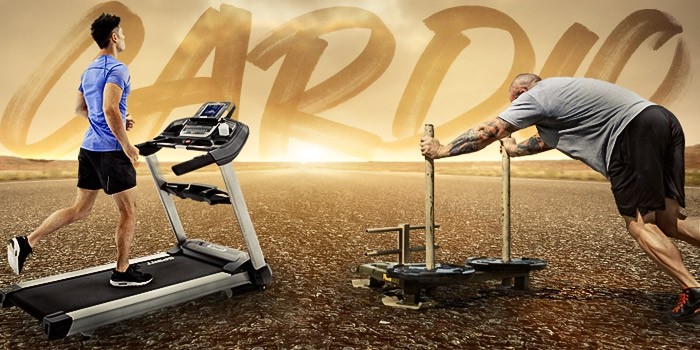
In an article I wrote a few months back, I explained the fundamental components of energy systems to give you a better understanding of conditioning.
In that article, I broke down the benefits of training each energy system and how to target them in your training.
If you missed it, CLICK HERE and read it now before going any further. Because today, we’re going to dive deeper into how you can take your conditioning to the next level.
First, let’s define conditioning.
In the simplest sense, conditioning is how well your energy systems can produce the energy needed to perform a specific task.
In my previous article, I told you about ATP and the three energy systems your body uses to produce it.
When it comes to conditioning, we need to consider how fast our systems can produce ATP, how long we can produce it for, and how efficiently your body can utilize the ATP being produced.
To do that, we must target the body’s different energy systems in the appropriate doses through training to create the right balance between all three energy systems.
My goal today is to teach you the specific adaptations we can create by targeting each specific energy system in your training.
If you’re an athlete or a coach, it’s important to understand these different systems, the different adaptations that can occur by targeting them, and how they work together.
Before we begin, I’d like to credit and acknowledge Joel Jamieson and all of his work. He has had a strong influence on me as a coach and a lot of what I discuss in this article I’ve learned through his articles and his book, Ultimate MMA Conditioning—a must read for anyone who wants to understand conditioning.
Now let’s dive into it.
The aerobic system, also known as the oxidative phosphorylative pathway, is the energy system that uses oxygen to produce ATP. This system is capable of producing ATP at a much longer duration than the two anaerobic systems but at a much slower rate.
When looking at athletic events, this system is responsible for energy production for long-duration endurance events where the capacity of energy production is what counts.
It’s also important to note that the aerobic system is not only utilized for long-duration energy production, but it is also responsible for replenishing the anaerobic energy systems when they’re being utilized. This allows the anaerobic systems to recharge so they can produce ATP again after they’ve been depleted from intense activity. But we’ll get deeper into that in a bit.
For now, just know that without a well-developed aerobic system, your anaerobic energy systems will also be underdeveloped.
In my last article, I explained how your anaerobic systems are responsible for your speed and power. But check this out:
Although your anaerobic energy systems are primarily responsible for speed and power, you can train to increase the rate at which your AEROBIC system can produce ATP. And here’s what’s important about that:
The more you can utilize the aerobic system for producing ATP while working at a higher intensity, the more you can postpone tapping into your anaerobic energy systems. The more that’s prolonged, the better your conditioning will be because the body really begins to fatigue at a higher rate once the anaerobic systems are tapped into.
So an important goal to improve your conditioning is to train your aerobic system to produce ATP at a faster rate. So let’s look into this.
The rate at which your aerobic system can produce ATP is called Aerobic Power.
A key to great endurance is increasing your aerobic power so you can use the aerobic system longer before having to tap into your anaerobic systems.
But eventually, if you’re training at a high enough intensity, there will be a shift from mostly aerobic energy production to anaerobic energy production.
The point at which your body switches from primarily aerobic energy production to anaerobic is called the anaerobic threshold. It is at this point where athletes who compete and train at high intensities will start to fatigue.
The anaerobic threshold can be measured by a specific heart rate range. The higher the heart rate range of the anaerobic threshold, the greater the potential of the athlete’s conditioning.
Improving aerobic power will raise the anaerobic threshold.
When the anaerobic threshold is reached, the muscles will significantly begin to produce a substance called lactate, which we’ll get back to in just a second.
So, for the aerobic energy system to improve, one to three things must happen.
- The heart must be able to supply more oxygenated blood to the working muscles.
- The muscle must be able to draw more oxygen out of the blood.
- More sugars and fats must be available to produce aerobic energy.
Let’s briefly look into each of these:
- In order for the heart to supply more oxygenated blood to the working muscles, you must focus on strengthening the heart. Two adaptations we can create through training is the size of the chambers of the heart and how hard the heart can contract with each beat.
- In order for muscle to draw enough needed oxygen from the blood, we must target the muscle fibers themselves through training. Slow twitch fibers predominantly rely on the aerobic system, which depends on oxygen. Fast twitch fibers, on the other hand, can use both aerobic and anaerobic systems. The goal in training is to target the fast twitch fibers in a way to improve their ability to utilize oxygen and enhance their endurance capabilities.
- In order for there to be enough sugars and fats available, we must enhance your capacity to store them.
When any of these things occur, your aerobic system improves, as does your conditioning. But this is just one piece of the puzzle. Let’s shift gears to anaerobic energy production.
The first anaerobic energy system I’d like to talk about is the Anaerobic Alactic system, or the ATP-PC system.
This system can only produce ATP for about 12 seconds at 100 percent intensity but can produce ATP very quickly without oxygen. This is because it has very few steps involved in the process of ATP production.
Rather than utilizing stored sugars and fats, the anaerobic alactic system depends on a chemical called phosphocreatine to regenerate ATP.
The alactic system has a giant genetic component, which means this system is the least trainable for adaptation. That doesn’t mean you cannot see any adaptations, as this depends on different variables, like training age for one.
It’s important to remember that although this system is critical for maximal power, the aerobic system helps to remove waste products produced when this system is in use. This is vital to understand for any athlete involved in mixed energy system sports because the aerobic system plays such a major role in “recharging” the anaerobic alactic system, which allows for more energy production once recovered.
Even if you play a sport that’s primarily alactic, like football, you must work to improve the aerobic system to enhance the body’s ability to recover in between plays.
Put simply, it’s vital to incorporate aerobic training into your program even if your sport is predominantly anaerobic, something I got wrong as a coach in my earlier years.
The adaptation we’re looking for through training the anaerobic alactic system should be to maximize how much power your alactic system can produce while enhancing the rate at which the aerobic system can recharge this system.
Finally, let’s discuss the Anaerobic Lactic system, also known as the Glycolytic Pathway.
This anaerobic energy system can produce ATP for over a minute and breaks down blood glucose or stored glycogen to do so.
Earlier I discussed that the more dependent you are on your anaerobic lactic system over your aerobic system, the faster you will fatigue. The measuring stick for when these systems switch over is the accumulation of lactate.
Lactate is a byproduct of the processes that occur when the body breaks down sugar.
Once the anaerobic lactic system is operating in full swing, lactate begins to accumulate. This is the anaerobic threshold which I discussed earlier.
Again, the higher the heart rate range of your anaerobic threshold, the more we can prolong fatigue.
However, in sports that require well-trained anaerobic lactic systems, it’s vital to increase the body’s tolerance to lactate accumulation. Although we can prolong this from happening, we can’t prevent it.
The better an athlete’s tolerance to lactate build up, the longer the duration they can utilize this energy system before slowing down. This means if you can enhance the tolerance of lactate accumulation, you can continue to tap into this energy system for a longer time, thus more rapid ATP production.
The more rapid the production of ATP, the greater the power output for a longer period of time.
When training this system, we are looking for two adaptations:
- Enhance lactic power, or how much power your anaerobic lactic system is capable of producing.
- Enhance lactic capacity, or how long you can sustain anaerobic lactic energy production.
The more power this system can generate, and the longer it can generate it for, the better your conditioning will be.
As you can see, energy systems are incredibly complex. This article barely scratches the surface, but it’s a start to understanding how the body produces energy for your sport.
Hopefully, now you have a better grasp of these energy systems and the adaptations that can occur from training them.
In a future article, I’ll break down the different ways that you can target these systems so you can train your athletes to have the endurance to outlast anyone!
If you have any questions, feel free to drop a comment below or hit me with a DM on Instagram @chris_tutela.
Thanks for reading!










